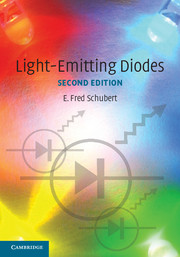Book contents
- Frontmatter
- Contents
- Preface
- 1 History of light-emitting diodes
- 2 Radiative and non-radiative recombination
- 3 Theory of radiative recombination
- 4 LED basics: Electrical properties
- 5 LED basics: Optical properties
- 6 Junction and carrier temperatures
- 7 High internal efficiency designs
- 8 Design of current flow
- 9 High extraction efficiency structures
- 10 Reflectors
- 11 Packaging
- 12 Visible-spectrum LEDs
- 13 The AlGaInN material system and ultraviolet emitters
- 14 Spontaneous emission from resonant cavities
- 15 Resonant-cavity light-emitting diodes
- 16 Human eye sensitivity and photometric qualities
- 17 Colorimetry
- 18 Planckian sources and color temperature
- 19 Color mixing and color rendering
- 20 White-light sources based on LEDs
- 21 White-light sources based on wavelength converters
- 22 Optical communication
- 23 Communication LEDs
- 24 LED modulation characteristics
- Appendix 1 Frequently used symbols
- Appendix 2 Physical constants
- Appendix 3 Room temperature properties of III–V arsenides
- Appendix 4 Room temperature properties of III–V nitrides
- Appendix 5 Room temperature properties of III–V phosphides
- Appendix 6 Room temperature properties of Si and Ge
- Appendix 7 Periodic system of elements (basic version)
- Appendix 8 Periodic system of elements (detailed version)
- Index
15 - Resonant-cavity light-emitting diodes
Published online by Cambridge University Press: 05 September 2012
- Frontmatter
- Contents
- Preface
- 1 History of light-emitting diodes
- 2 Radiative and non-radiative recombination
- 3 Theory of radiative recombination
- 4 LED basics: Electrical properties
- 5 LED basics: Optical properties
- 6 Junction and carrier temperatures
- 7 High internal efficiency designs
- 8 Design of current flow
- 9 High extraction efficiency structures
- 10 Reflectors
- 11 Packaging
- 12 Visible-spectrum LEDs
- 13 The AlGaInN material system and ultraviolet emitters
- 14 Spontaneous emission from resonant cavities
- 15 Resonant-cavity light-emitting diodes
- 16 Human eye sensitivity and photometric qualities
- 17 Colorimetry
- 18 Planckian sources and color temperature
- 19 Color mixing and color rendering
- 20 White-light sources based on LEDs
- 21 White-light sources based on wavelength converters
- 22 Optical communication
- 23 Communication LEDs
- 24 LED modulation characteristics
- Appendix 1 Frequently used symbols
- Appendix 2 Physical constants
- Appendix 3 Room temperature properties of III–V arsenides
- Appendix 4 Room temperature properties of III–V nitrides
- Appendix 5 Room temperature properties of III–V phosphides
- Appendix 6 Room temperature properties of Si and Ge
- Appendix 7 Periodic system of elements (basic version)
- Appendix 8 Periodic system of elements (detailed version)
- Index
Summary
Introduction and history
The resonant-cavity light-emitting diode (RCLED) is a light-emitting diode that has a lightemitting region inside an optical cavity. The optical cavity has a thickness of typically one-half or one times the wavelength of the light emitted by the LED, i.e. a fraction of a micrometer for devices emitting in the visible or in the infrared. The resonance wavelength of the cavity coincides or is in resonance with the emission wavelength of the light-emitting active region of the LED. Thus the cavity is a resonant cavity. The spontaneous emission properties from a lightemitting region located inside the resonant cavity are enhanced by the resocant-cavity effect. The RCLED is the first practical device making use of spontaneous emission enhancement occurring in microcavities.
The placement of an active region inside a resonant cavity results in multiple improvements of the device characteristics. Firstly, the light intensity emitted from the RCLED along the axis of the cavity, i.e. normal to the semiconductor surface, is higher compared with conventional LEDs. The enhancement factor is typically a factor of 2–10. Secondly, the emission spectrum of the RCLED has a higher spectral purity compared with conventional LEDs. In conventional LEDs, the spectral emission linewidth is determined by the thermal energy kT. However, in RCLEDs, the emission linewidth is determined by the quality factor (Q factor) of the optical cavity.
- Type
- Chapter
- Information
- Light-Emitting Diodes , pp. 255 - 274Publisher: Cambridge University PressPrint publication year: 2006
- 1
- Cited by

